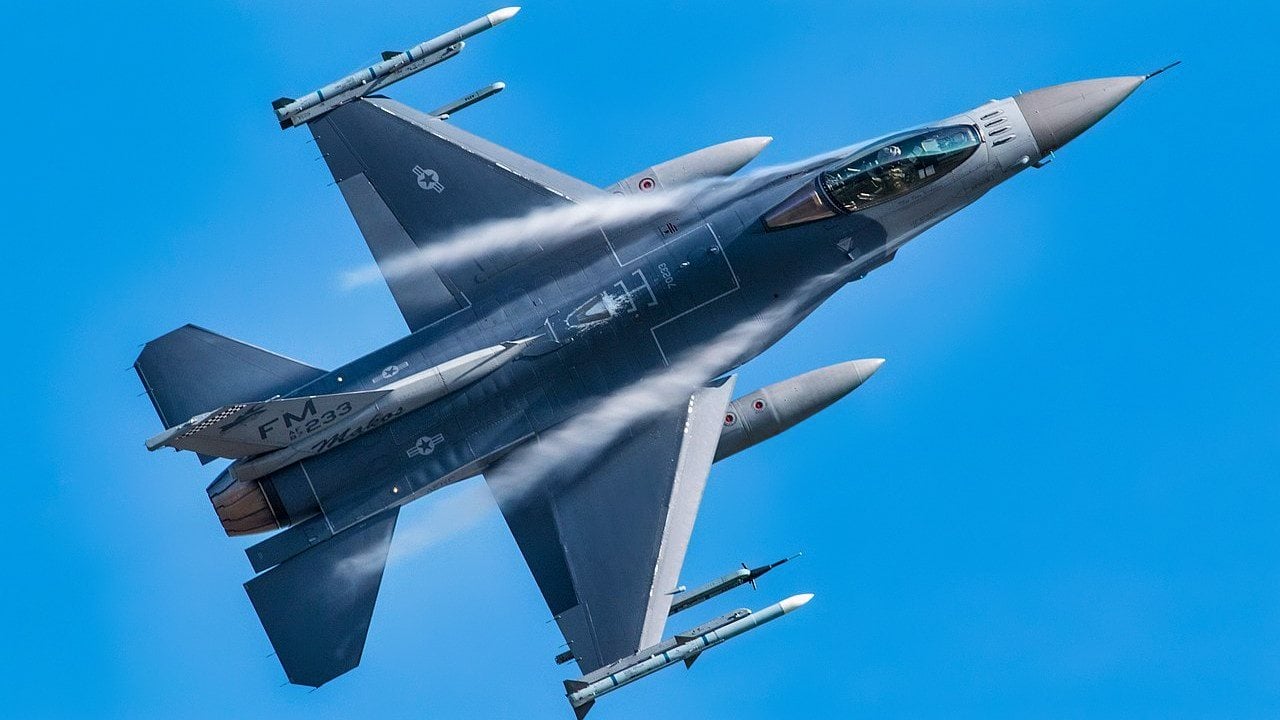How to Make the F-16 Fighter Even Deadlier: Give It an A-10 Warthog Cannon
In the twilight of the Cold War, the U.S. Air Force explored replacing the A-10 Thunderbolt II, known for its 30mm GAU-8 Avenger cannon, with a variant of the F-16, dubbed the A-16 and later the F/A-16.
So, the Air Force opted for a different approach – looking to aircraft that were already in service and demonstrating the sort of high-speed survivability it was looking for, and then simply trying to strap the A-10’s massive 30mm cannon to them instead.
To accomplish this, the Air Force kicked off a new program dubbed “Pave Claw,” which sought to reduce the size and weight of the Avenger rotary cannon and then stuff it into a gun pod that could be carried by other, more survivable, jets.
The original GAU-8 was so massive that the A-10 had to be designed around it to accommodate all seven of its 7-foot-long barrels, a hearty firing mechanism and feed system, and the ammunition drum that, alone, was nearly six feet long and 34.5 inches in diameter. The gun system itself weighed only around 620 pounds, but when fully loaded with 1,350 rounds of 30×173 mm ammunition, its weight skyrocketed to a hefty 4,029 pounds.
The first order of business, then, was to bring the weight down, so the Air Force started by reducing the number of barrels in its new pod-based 30mm cannon from seven to four. While the A-10’s GAU-8 was powered by a pair of hydraulic motors, each with independent redundant hydraulic systems, the pod-based cannon would use a single pneumatic drive system powered by a 3200psi composite bottle of compressed air.
The biggest source of weight for the GAU-8 was its Coke-bottle-sized 30mm depleted uranian armor-piercing rounds, and there was no way a pod-based variant would be able to carry as much of this ammunition as the A-10.
Nonetheless, a cleverly designed helical magazine that saw the rounds spiral around the gun inside the pod made it possible to carry 353 rounds onboard. With fewer barrels and a different drive system, this new 30mm gun pod could only manage a comparatively measly 2,400 rounds per minute – just over half of the GAU-8’s maximum – but could nonetheless put 40 rounds on target per second. When you account for the half-second it took for the barrels to get to speed, that meant a pilot could burn through every round onboard in under 10 seconds of sustained fire, but in those 10 seconds, this new gun pod could unleash some serious destruction.
This new four-barrel 30mm cannon was dubbed the GAU-13/A. Once complete, it weighed in at just 333 pounds and stretched just over nine feet long, making it roughly half the weight of the GAU-8 at less than half the length. The pod that housed the weapon was entirely self-contained and designed to be mounted on just about any tactical aircraft with standard 30-inch lugs, including the F-15 Eagle (the Strike Eagle wouldn’t emerge until years later). However, the Air Force already had one very specific fighter in mind… the broadly capable and extremely agile F-16 Fighting Falcon.
Turning the F-16 into the A-16
The General Dynamics F-16 Fighting Falcon entered service just one year after the A-10, but from a technological standpoint, it was practically from another era. Meant to serve as a low-cost supplement to the immensely expensive F-15 Eagle, the small and nimble F-16 was the first production fighter ever to incorporate fly-by-wire control, which brought with it a revolution in fighter design that coincided with the advent of John Boyd and Thomas Christie’s Energy–maneuverability theory model of aircraft performance.

The F-16 was the first fighter designed for combat in the truly modern sense, embracing quantitative data over the pervasive belief at the time that air-to-air combat was more artform than science.
Aircraft up until that point had been designed to have what’s commonly known as “positive static stability,” which means the aircraft is shaped in such a way that air flowing over its wings and control surfaces will make it stable by default, forcing the pilot to trade either kinetic energy (speed) or potential energy (altitude) to overcome that inherent stability and perform aerobatic maneuvers. The F-16, on the other hand, was inherently unstable, but used an onboard flight control system to make constant small adjustments to the positioning of its control surfaces to make it seem stable in level flight.
As a result, this new fighter didn’t need to trade nearly as much energy to snap into aggressive aerobatic maneuvers, allowing it to retain as much speed and altitude (energy) as possible. The more energy the aircraft maintains, the more it has to trade for further maneuvers, and the bigger the advantage it has in a dogfight.
Yet, while the F-16 was envisioned as an all-business dogfighter by Boyd and his controversial group of colleagues known as the Fighter Mafia, it wasn’t long before the Air Force came to realize that this nimble new fighter could do a whole lot more than air-to-air combat. The F-16 entered service in 1978 but proved so well suited for ground-attack operations that by 1981, every F-16 to roll off the assembly line came standard with the built-in structural and wiring provisions required to leverage air-to-ground bombs and missiles.
The very next year, production began on the GAU-13/A and its GBU-5 gun pod, which the Air Force believed could turn the air-to-air focused multi-role F-16 into an attack-specific 30mm CAS machine. Before long, the branch began setting F-16 airframes aside for this new role, which came to be known as the A-16, swapping out that F-for-fighter prefix in favor of a new A-for-attack designation.
This new Block 60 A-16 would boast a great deal of onboard firepower, delivered primarily by its massive GAU-13 30mm cannon, but boosted by twin 7.62mm miniguns mounted in their own pods under each wing. Targeting for all this firepower would be bolstered by a new conformally mounted FLIR targeting system dubbed “Falcon Eye;” this was then integrated with the “Cat’s Eye” helmet-mounted targeting sight that was similar, in some respects, to the monocle sighting systems employed by Apache helicopter pilots. These changes, and a slew of others, however, saw the A-16 concept quickly balloon in both price and weight, effectively eliminating two of the F-16’s primary strengths in the Air Force’s eyes.
Two existing Block 15 F-16s were modified and converted into the A-16 trim at Shaw Air Force Base for testing, but the effort was curtailed by a lively debate about what kind of aircraft was truly suitable for the CAS mission. Some argued that the A-16, while certainly quick and agile, lacked the rugged toughness required to survive the hornet’s nest of small arms fire such an aircraft would have to contend with, while others made the now familiar claims that the A-10 was simply too slow to survive in modern battlespaces.
Ultimately, however, the argument was made moot in 1990 when the U.S. Air Force was ordered to maintain two wings of A-10s for the CAS mission, effectively killing off the A-16 concept the branch had hoped could serve as a suitable replacement.
Congress forced the Air Force to keep its Warthogs, but the branch wasn’t happy with that and kicked off a sizable retrofit of some 400 F-16s with a slew of new CAS-focused systems, even if the GBU-5 gun pod was not among them.
Then as the Desert Storm air campaign kicked off in the early days of 1991, the Air Force saw its opportunity to demonstrate that the F-16 really could fly and fight using its podded 30mm rotary cannon. A group of 24 F-16As and F-16Bs out of the 174th Tactical Fighter Wing of the New York Air National Guard were equipped with the GBU-5 30mm gun pod and re-designated F/A-16s, combining both fighter and attack prefixes.
These aircraft flew into the fight with the Air Force’s CAS hopes resting on their shoulders, but despite the best efforts of the pilots, the 30mm gun pods just didn’t live up to expectations.
First and foremost, the centerline pylon mount for the nearly 2,000-pound (when fully loaded) gun pod quickly proved insufficient for the job, with the weapons knocking themselves off-center after just a second or two of sustained fire, eliminating the weapon’s zero and making it all but impossible to accurately lay down fire. While that could likely be addressed with just a bit more R&D, the other issues were inherent to the differences between how the F-16 and A-10 were designed to operate.
Although the A-10 flies at a standard cruising speed of around 335 miles per hour while engaging ground targets, the F-16’s cruising speed is usually almost twice that, at just shy of 600 miles per hour. In theory, this added speed would make the F/A-16 a harder target for ground troops, but in practice, it meant the A-16’s pilot had significantly less time to line up a target during their shallow dive toward the earth on a gun run. And of course, when the weapon was firing, it created such immense vibrations within the aircraft that there were palpable concerns about potential damage to onboard electronics.
Within only a day or so of combat operations, F/A-16 crews transitioned to using the 30mm gun pod as an area-effect weapon, effectively giving up on the idea of precise targeting in favor of using its massive rounds more like cluster munitions over a broader area. Within just two days of combat operations, the entire idea was scrapped, the gun pods were removed, and America’s only-ever F/A-16s transitioned back to their conventional bomb-dropping roles.


